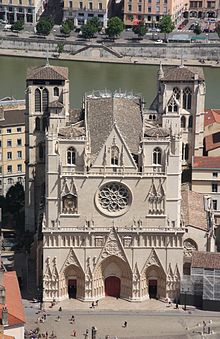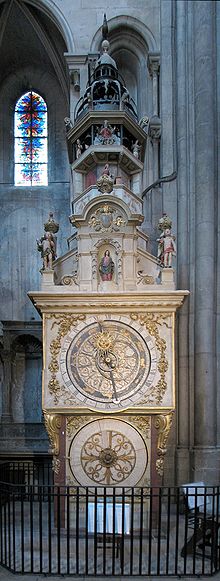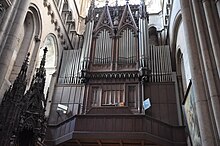Lyon Cathedral
The cathedral Saint-Jean (French officially Église Saint-Jean-Baptiste-et-Saint-Étienne or Cathédrale Saint-Jean-Baptiste de Lyon ) was built from around 1165 and is next to the Basilica Notre-Dame de Fourvière the most important church building in the City of Lyon and seat of the Archbishop of Lyon . The cultural monument , which has been classified as a monument historique since 1862 and is therefore under monument protection , can be assigned to the Romanesque and Gothic styles. The church dominates the Vieux Lyon district , where it is located not far from the banks of the Saône .
history
A first church building is said to have stood here as early as the time of the city's first bishops, Pothinus and Irenaeus of Lyon , in the 2nd century, but there are no more traces of this. The oldest remains of the building date from the 6th century. At that time the relics of Saints Irenaeus , Epipodius and Alexander were brought under the altar of the church. The cathedral has been called the Primatiale since 1079, when Pope Gregory VII bestowed the honorary title Primatiale of Gaul on the Archdiocese of Lyon .
Today's construction
During the construction of the new cathedral in the 12th century, a conflict broke out between the archbishop and the cathedral chapter: the chapter had chosen Dreux de Beauvoir as archbishop, a Cluniac during Pope Alexander III. appointed a Cistercian, Guichard de Pontigny. The first was a supporter of the emperor and antipope Victor IV, the second was the pope's husband. The first loved the pomp and liturgy of Cluny, the other the austerity of the Reform Order; Dreux came from the Lyon chapter and did everything possible to promote it; Guichard had been sent by the Pope to reform the chapter. In the end, the cathedral was started in the east with the richly decorated choir according to the ornate ideals of the cathedral chapter around 1165.
First, the lower parts of the apse up to the triforium and the two side chapels with the vaults, which were completed around 1180/93, began. This was followed by the transept (which was already executed in Gothic style), the upper windows and the vault of the apse and the transept, the two east towers and parts of the main nave until the first third of the 13th century . In the middle of the 13th century the glass windows of the choir and the rosette of the transept followed.
Towards the end of the 13th and beginning of the 14th centuries, the main nave and from around 1308 the lower part of the facade were built. The upper part of the facade and the two western towers followed in the 15th century. The conclusion was a statue of Christ, which was placed on the gable in 1481.
Important events
In 1245 the church was the scene of the First Council of Lyon , at which the Pope declared Emperor Friedrich II deposed. In 1271 the body of the French King Louis IX was here for a short time . laid out who died in Tunisia during the last crusade; he was eventually buried in the Saint-Denis basilica . In 1274, the Second Council of Lyons took place in the cathedral , at which primarily the union of the Catholic and Greek Orthodox Churches was discussed. On August 17, 1316 John XXII. elected Pope in the cathedral; he was the second of the Avignon popes ; his elaborate choice earned him the nickname “Fox of Cahors”.
In 1562 the church was devastated by Calvinist Huguenots . On December 17, 1600, the cathedral was the site of the marriage between King Henry IV and Maria de Medici . Richelieu received his cardinal dignity here in 1622 . In the 1790s, Bishop Lamourette had the choir redesigned and the rood screen removed. From 1935 the choir was restored to its medieval form. In 1982 the facade was newly plastered. In 1986 Pope John Paul II paid a visit to the cathedral. In 2018 the funeral mass for Paul Bocuse took place in the church .
architecture
The cathedral is 80 meters long, 20 meters wide at the height of the choir and the height of the nave is 32.50 meters.
For the facade, stones from the city's old Roman forum were used. Since it comes from the 14th and 15th centuries, it is strongly influenced by the Flamboyant style . Episodes from the Old and New Testament are told in 300 image fields. The Huguenot Baron des Adrets had the statues destroyed in the 16th century and the heads of the angel figures on the three portals chopped off.
Inside, the stylistic development can be clearly followed when one moves from the apse and choir, which are still Romanesque, towards the main nave and entrance and increasingly notices Gothic elements. The glass windows, made around 1390, are in blue-violet tones, with cooler tones dominating in the south-facing windows to compensate for the stronger solar radiation. At the end of the choir stalls are two statues made by Blaise in 1776 and 1780, respectively, depicting Saint Stephen and Saint John the Baptist, the two namesake of the cathedral.
Two large crosses have been placed on the right and left of the altar since 1274, commemorating the planned union of the Catholic and Orthodox churches. Also worth seeing is the Bourbon Chapel, built in the 15th century for Cardinal Charles de Bourbon and his brother Pierre , who worked closely with King Louis XI. were related.
Astronomical clock
The astronomical clock dates from the 14th century and was later renewed several times. It is one of the oldest clocks in Europe. The first references to the clock are given in documents from 1383.
The clock itself is laid out in the shape of a tower, about 1.80 m wide and 9.35 m high. In the lower part is the date display, in the middle part the actual clock. The positions of the moon, sun and earth and the time of the rise of the most important stars are also displayed. With a view to its function as a clock, the sun circles the earth. The scale of the date display was adjusted in the 1950s and extends until 2019.
Above the actual clockwork there is a multi-level structure with a cock attachment. The attachment also contains an automatic mechanism and a bell mechanism, both of which come into action several times a day. The rooster “crows” three times, combined with flapping its wings and opening its beak. This is followed by an automatism that shows the biblical scene in which the Virgin Mary receives the message of the Lord from the Archangel Gabriel.
art
The cathedral is particularly richly decorated with numerous paintings and statues. The numerous windows and rosettes are particularly noteworthy.
Organs
The large organ on the west gallery was built in 1851 by the organ building company Daublaine et Callinet in a neo-Gothic organ case. Shortly after completion, the instrument was restored, rebuilt and expanded several times. The organ was finally extensively rebuilt in the years 1935–1936 by the organ builders Merklin and Kuhn . Today the instrument has 56 stops on three manuals and a pedal .
|
|
|
|
|||||||||||||||||||||||||||||||||||||||||||||||||||||||||||||||||||||||||||||||||||||||||||||||||||||||||||||||||||||||||||||||||||||||||||||||||||||||||||||||||||||||||||||
An organ by Jürgen Ahrend , which was created in 1974 for the Taizé Reconciliation Church, has been installed in the north transept since 1996 . It is designed according to the principles of classic French organ building by Clicquot and Andreas Silbermann . After its dismantling in 1979 and installation in the monastery church of the former Payerne Abbey in 1981, it was transferred to Lyon in 1996. The instrument has 28 registers, which are divided into three manuals and pedal.
Bells
The cathedral has nine bells . The six bells of the main chime sound roughly in the striking tones as 0 , b 0 , c 1 , f 1 , g 1 and a flat 1 . In the sound window of the northwest tower hang three bells for the clock strike .
See also
Web links
- Cathedral website (fr.)
- The cathedral on www.culture.gov (fr.)
- The cathedral on www.easyvoyage.de
- Entry on de.structurae.de
Individual evidence
- ^ Genealogy-Mittelalter.de: Article about Margarete von Valois , requested on December 12, 2009
- ↑ Archived copy ( memento of the original from January 28, 2018 in the Internet Archive ) Info: The archive link was inserted automatically and has not yet been checked. Please check the original and archive link according to the instructions and then remove this notice.
- ↑ Further information on the astronomical clock ( Memento of the original from March 23, 2011 in the Internet Archive ) Info: The archive link was inserted automatically and has not yet been checked. Please check the original and archive link according to the instructions and then remove this notice. on the cathedral website
- ↑ a b Further information on the organs , accessed on December 27, 2016.
Coordinates: 45 ° 45 ′ 38 " N , 4 ° 49 ′ 39" E








